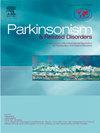Cropland associated with risk of Parkinson's disease in the northern Great Plains
IF 3.1
3区 医学
Q2 CLINICAL NEUROLOGY
引用次数: 0
Abstract
Introduction
We sought to identify regional associations between cropland density and crop types and PD in the U.S.
Methods
We conducted a population-based study of 21,639,190 Medicare beneficiaries, 89,790 with incident PD in 2009. We used county-level geographic weighted regression (GWR) to identify region(s) of the U.S. where the association between PD RR and cropland density was strongest. In a broad region identified by GWR in which cropland density was associated with PD, we performed logistic regression using individual-level beneficiary data (2733 cases and 805,984 non-cases) with high-resolution cropland density data. We adjusted for age, sex, race, smoking, healthcare utilization, and PM2.5 (particulate matter <2.5 μm). We then explored PD-cropland associations for each type of crop within a subregion, in which the association was the strongest.
Results
GWR identified a 9-state region in the Great Plains in which county-level cropland density and PD RR were associated. Within this region, the strongest GWR coefficients centered around the Williston Basin. High-resolution analysis demonstrated an association between cropland density within a 5-mile radius of residential zip+4 and PD. When comparing the highest to lowest quartile of cropland density, the odds ratio (OR) for PD was 1.14 (95 % confidence interval [CI] 1.01–1.27) in the 9-state region and 1.99 (95 % CI 1.09–3.61) in the Williston Basin. In the Williston Basin, percentage of sunflowers, winter wheat, and alfalfa within 5 miles of a beneficiary's zip+4 was associated with PD.
Conclusion
We identified a region-specific association between cropland and crop type and PD in the Williston Basin.
求助全文
约1分钟内获得全文
求助全文
来源期刊

Parkinsonism & related disorders
医学-临床神经学
CiteScore
6.20
自引率
4.90%
发文量
292
审稿时长
39 days
期刊介绍:
Parkinsonism & Related Disorders publishes the results of basic and clinical research contributing to the understanding, diagnosis and treatment of all neurodegenerative syndromes in which Parkinsonism, Essential Tremor or related movement disorders may be a feature. Regular features will include: Review Articles, Point of View articles, Full-length Articles, Short Communications, Case Reports and Letter to the Editor.
 求助内容:
求助内容: 应助结果提醒方式:
应助结果提醒方式:


